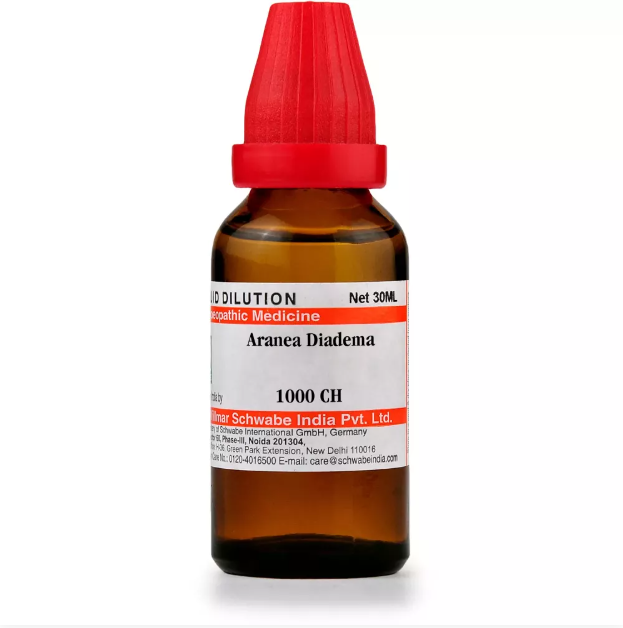ARANEA DIADEMA 6C, 12C, 30C, 200C, 1M, 10M USES AND SYMPTOMS
 Effect on Nervous System: Potent poisons affect nervous system intensely (e.g., Tarentula hispanica, Mygale lasiodora).
Effect on Nervous System: Potent poisons affect nervous system intensely (e.g., Tarentula hispanica, Mygale lasiodora).
Symptom Characteristics: Symptoms show periodicity, coldness, and high susceptibility to dampness. Ideal for individuals prone to malaria-like poisoning, aggravated by damp and cold conditions. Profound coldness penetrates to the bones. Sensation of enlargement and heaviness in body parts. Awakens with hands feeling swollen at night. Enlarged spleen (splenomegaly).
Hydrogenoid Constitution: Extreme sensitivity to dampness and coldness. Aversion to living near fresh water bodies or in chilly, damp places (Nat-s., Thuj.).
Symptoms by Body Part:
Head: Right trigeminal nerve pain from periphery inward. Confusion relieved by smoking in open air.
Eyes: Heat and flickering, worsened by damp weather.
Mouth: Sudden, severe tooth pain at night after lying down.
Stomach: Cramps after minimal food; tenderness in epigastrium.
Abdomen: Recurrent colic at fixed hours. Heavy feeling, as of a stone; diarrhea.
Female: Early, profuse menses (menorrhagia); abdominal distension; lumbo-abdominal neuralgia.
Chest: Pain along intercostal nerve; bright red lung hemorrhage (hemoptysis).
Extremities: Bone pain; heel pain (os calcis); sensation of swelling and numbness.
Sleep: Restless sleep, frequent awakening with sensation of swollen, heavy hands and forearms.
Fever: Coldness, bone pain, sensation of abdominal stone at same hour daily. Worse during rainy, chilly periods.
Modality: Aggravation in damp weather, late afternoon, and midnight; improvement with tobacco smoking.
Relationships: Tela aranearum (Spider’s web) – cardiac sleeplessness, increased muscular energy, nervous agitation, dry asthma, periodic headaches, marked periodical diseases, lowered pulse rate. Aranea scinencia (Grey spider) – eyelid twitching, sleepiness worsened in warm rooms. Compatible with Helo., Cedr., Ars.
Dosage: Tincture to thirtieth potency.
SYMPTOMS OF ARANEA DIADEMA
Effect on Nervous System: Potent poisons affect nervous system intensely.
Characteristic Symptoms:
Periodicity, coldness, and sensitivity to dampness.
Coldness penetrating to the bones.
Sensation of enlargement and heaviness in body parts.
Swollen hands sensation at night.
Enlarged spleen (splenomegaly).
Extreme sensitivity to dampness and coldness.
Head:
Right trigeminal nerve pain.
Confusion relieved by smoking in open air.
Eyes:
Heat and flickering, worsened by damp weather.
Mouth:
Sudden, severe tooth pain at night.
Stomach:
Cramps after minimal food; epigastrium tenderness.
Abdomen:
Recurrent colic at fixed hours.
Heavy feeling, diarrhea.
Female:
Early, profuse menses; abdominal distension; lumbo-abdominal neuralgia.
Chest:
Intercostal nerve pain; bright red lung hemorrhage (hemoptysis).
Extremities:
Bone pain; heel pain; sensation of swelling and numbness.
Sleep:
Restless sleep, frequent awakening with swollen, heavy hands and forearms.
Fever:
Coldness, bone pain, abdominal stone sensation at same hour daily.
Modality: Aggravation in damp weather, late afternoon, and midnight; improvement with tobacco smoking.
Relationships: Compatible with other remedies like Spider’s web, grey spider, Helo., Cedr., Ars.
Dosage: Tincture to thirtieth potency.
selection of the potency
Individualization:
- Homeopathy is based on the principle of treating the individual, not just the disease. The unique symptoms and characteristics of the person are crucial in determining the most suitable potency.
Intensity of Symptoms:
- The intensity of the symptoms guides the choice of potency. If the symptoms are intense and acute, a lower potency (e.g., 6C, 30C) might be considered. For chronic conditions with less intensity, higher potencies (e.g., 200C, 1M) may be appropriate.
Sensitivity of the Patient:
- Some individuals are more sensitive to homeopathic remedies, while others may require higher potencies. The practitioner considers the patient’s sensitivity when selecting the potency.
Acute vs. Chronic Conditions:
- Lower potencies are often used for acute conditions, while higher potencies may be considered for chronic or long-standing issues.
Previous Response to Potencies:
- The patient’s response to previous homeopathic treatments helps guide the choice of potency. If a particular potency has been effective in the past, it may be repeated or adjusted as needed.
Vital Force and Susceptibility:
- Homeopathy views illness as a disturbance in the vital force. The practitioner assesses the patient’s overall vitality and susceptibility to determine the appropriate potency.
Aggravation or Amelioration:
- The direction of the symptom response (aggravation or amelioration) after taking a remedy can influence the choice of potency.
Miasmatic Considerations:
- In classical homeopathy, the concept of miasms (inherited disease tendencies) is considered. The practitioner take this into account when selecting the potency.
Practitioner Experience:
- The experience and preference of the homeopathic practitioner play a role. Some practitioners may have success with certain potencies based on their clinical experience.
SAFETY INFORMATION
- Do not exceed the recommended dose by physician
- Keep out of the reach of children
- Store in a cool dry place away from direct sunlight
- Maintain half an hour gap between food/drink/any other medicines and homoeopathic medicine
- Avoid any strong smell in the mouth while taking medicine e.g. camphor, garlic, onion, coffee, hing
Medicine images use for reference only selection of homeopathic medicine depends on the individual’s specific symptoms and overall constitution. Moreover, homeopathy is a holistic system of medicine that treats the individual as a whole. In addition to addressing the physical symptoms, it takes into account the emotional and mental state of the person. Consequently, it’s crucial to consult with a qualified homeopathic practitioner for personalized treatment.
The information provided on this website is intended solely for educational purposes. Always seek the advice of your physician or other qualified health provider.
